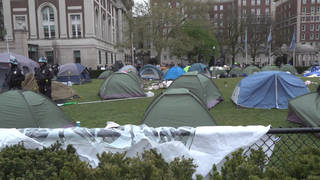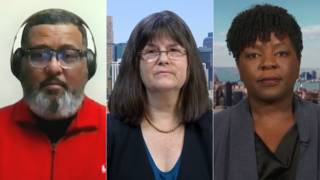
Related
Guests
- Douglas Blackmonauthor of Slavery by Another Name: The Re-Enslavement of Black Americans from the Civil War to World War II. He is also the bureau chief for the Wall Street Journal in Atlanta.
A new book by award-winning journalist Douglas Blackmon uncovers the forgotten history of neo-slavery imposed on hundreds and thousands of African Americans that continued well after the Civil War and persisted right up to the 1940s. Using extensive archival sources, Blackmon uncovers the shameful system created to re-enslave African Americans. Under new laws, they were intimidated, arrested, charged with exorbitant fines, and then sold as forced laborers to corporations, mines and plantations or compelled into involuntary servitude. [includes rush transcript]
Transcript
JUAN GONZALEZ: We now turn back in time to one of the ugliest chapters in American history: slavery. Most people think that this shameful chapter was closed with Lincoln’s Emancipation Proclamation in 1863 and with even more finality in 1865 with the passage of the 13th Amendment to the Constitution that banned slavery.
But a new book by Douglas Blackmon uncovers the forgotten history of neo-slavery imposed on hundreds and thousands of African Americans that continued well after the Civil War and persisted right up to the 1940s. Using extensive archival sources, Blackmon uncovers the shameful system created to re-enslave African Americans.
AMY GOODMAN: Under new laws, they were intimidated, arrested, charged with exorbitant fines, then sold as forced laborers to corporations, mines and plantations or compelled into involuntary servitude.
The book is called Slavery by Another Name: The Re-Enslavement of Black People in America from the Civil War to World War II. Author Douglas Blackmon is an award-winning journalist, also the bureau chief of the Wall Street Journal in Atlanta. He joins us now from Atlanta.
Welcome to Democracy Now!
DOUGLAS BLACKMON: Thanks for having me.
AMY GOODMAN: Why Slavery by Another Name? Why that title?
DOUGLAS BLACKMON: Because this was slavery, even though we didn’t call it that. The legal institution of slavery, the legal concept of slavery that had existed before 1865, had in fact been abolished, and there weren’t laws on the books anymore that authorized slavery, and you couldn’t file a deed on a slave down at the county courthouse anymore. But the reality was that in the years after the Civil War, all of the Southern states passed this array of new laws, which were specifically designed to intimidate African Americans out of the political process, to inhibit their ability to have economic success, and eventually to force first thousands, and then eventually hundreds of thousands, of African Americans back into a form of involuntary servitude. And it wasn’t called slavery, but it was slavery by another name.
JUAN GONZALEZ: Well, you’ve gone back into county records in areas across the South to unearth this story. Tell us about how the mechanisms actually worked, especially places like Alabama and Georgia, how they — and also, where were these victims enslaved into? What were the areas that they worked in?
DOUGLAS BLACKMON: Well, a lot of conventional history that’s been written about this period of time acknowledged that there was this abusive system of county sheriffs and county judges and the state courts leasing prisoners, people who had been convicted of crimes, leasing them out to — as a way of paying off their fines, leasing them to commercial interests like coal mines and iron ore mines, timber camps, turpentine stills, where turpentine was made from pine trees, which was an incredibly important commodity for the whole entire US economy at that time. And that story has been somewhat documented.
But what I did was I went across Alabama and Georgia and Florida and really all of the Southern states, but I went courthouse by courthouse across key areas of the Deep South and discovered enormous numbers of records which really hadn’t been looked at in a hundred years and which made it very clear that among these thousands of people who were arrested and forced into this form of forced labor, that huge numbers of them had committed no crimes at all, or they had been arrested and convicted on the most frivolous charges, like vagrancy or the inability to prove that they had a job at any time, which was something that almost no one could do in an era without pay stubs.
It was against the law in the South for a farm worker to change jobs, to move from one landowner to another landowner without the permission of the first landowner. Now, that law didn’t say it would only be applied to African Americans, but overwhelmingly it only was enforced against African Americans, with the specific purpose of making it impossible for huge numbers of black people to have any kind of economic mobility or to break free from this life of de facto slavery. And that was happening in a pervasive way in every Southern state by the beginning of the twentieth century.
JUAN GONZALEZ: You talk in particular about a brick factory in Atlanta, where you are based, and say that the modern city of Atlanta depended basically on this new enslaved labor to lay out its physical structure.
DOUGLAS BLACKMON: At the end of the nineteenth century, there was this enormous brick-making concern on the outskirts of Atlanta. And, in fact, the company still operates today in a somewhat different form. It was owned by one of the most prominent men in the city. He had been the mayor of Atlanta in the 1880s. His name was James English. He was a famous Confederate war veteran. He was politically the most powerful man in the city. And by the beginning of the twentieth century, he probably was the wealthiest man in the Southern United States and one of the wealthiest men in America.
He had many business concerns, but at the base of his wealth and the base of his enterprises was this brick-making factory, which was worked entirely with these forced laborers who had been acquired from jails and also simply purchased from men who had kidnapped black men from the roadways of the South, which became an incredibly common phenomenon as this new market for black labor developed. And the Chattahoochee brickyard, as it was called, was a place that generated millions and millions of bricks.
The workers there lived lives under excruciatingly terrible circumstances. They were starved, they were whipped, they were beaten. They didn’t receive medical care. Huge numbers of them died. Absolutely horrifying conditions that — but which were common to these forced labor camps that existed all over the South.
But those bricks, millions of them were purchased by the city of Atlanta to pave the streets and the sidewalks of the city. They’re in the foundations of almost every building in Atlanta that predates 1910, like the house that I live in and the sidewalks that I walk on in my neighborhood in downtown Atlanta.
AMY GOODMAN: Can you name the names of some other corporations. For example, you write about Morgan Stanley.
DOUGLAS BLACKMON: Not Morgan Stanley, but I mention JPMorgan as a company, that in the past I’ve written about the role of JPMorgan in — I did a story some years ago about — that sort of raised the question of, what are the responsibilities of a bank when it finds itself wittingly or unwittingly involved in the financing of some enterprise or the transfer of funds related to enterprises that in hindsight today look very, very suspect?
And so — but in terms of the companies that I write about in the book, there’s Chattahoochee Brick, Captain English’s enterprise, but he then, on the basis of that wealth, he then founded a different bank in Atlanta, which eventually became the largest financial institution, the most powerful financial institution, in the South and eventually was subsumed into what is today Wachovia Bank.
There was another great entrepreneur of Atlanta, equally important figure in the creation of the modern city, who also relied heavily on this form of labor in coal mines and iron ore mines. He founded a bank that is today SunTrust Bank. That bank and his other enterprises were instrumental in the creation of the modern Coca-Cola Company. He had other enterprises that became Georgia Power Company and Southern Company, which are two of the biggest utilities in the Southern United States.
In Alabama, US Steel Corporation was the largest player in operating mines where you had thousands and thousands of these forced laborers at work. And there are many other companies today that, in one manner or another, have some sort of a connection — whether they know it or not, they have some connection back to these terrible events of a hundred years ago.
AMY GOODMAN: US Steel?
DOUGLAS BLACKMON: US Steel Corporation.
JUAN GONZALEZ: And how was it — for instance, if someone was arrested on a vagrancy charge, you would assume that this would only be a very short sentence. How were they able to be then impressed into service for these companies for longer periods of time?
DOUGLAS BLACKMON: Well, take, for instance, the example of a man named Green Cottenham, around whom I built much of the narrative of the book. Green Cottenham was a child of former slaves who was born in the 1880s in the center of Alabama. And by the time he had reached adulthood, just after the turn-of-the-century, this whole new system of intimidation, really terror in many respects, had come into place against African Americans across the South.
And he was arrested in the spring of 1908, when a deputy sheriff in Columbiana, Alabama went out on a sweep, effectively, to round up a number of African American men, because a few days later, the man from the US Steel mine, who came by periodically to pick up laborers and take them back to the mines, would be arriving in a few days. And so, Green Cottenham was swept up. He was standing around with a number of other African Americans behind the train station in the town. And this group of men were arrested for no particular reason.
By the time they were brought before a judge two days later, the deputy couldn’t remember exactly what the charge had been, and so the original charge that’s written down on the day he’s arrested is different from the one that the judge finally decides to convict him of, which was simply vagrancy. And almost any farm worker, and certainly any indigent African American man, in 1908 could be charged with vagrancy, unless he had some powerful white man willing to step forward and say, “No, he works for me. He’s under my control.” Well, that didn’t happen for Green Cottenham, and so he is convicted of vagrancy.
He was sentenced to a fine of $10 or thereabouts, but on top of the fines, there would be imposed on these men — in those days, sheriffs and court clerks and many other government officials received their compensation not in salaries from the government, but from fees that were charged to the people they arrested and convicted. And so, in addition to his fine, there was almost $200 of additional fees tacked onto what he would have to pay to become free. Well, that’s two or three years’ wages in that era. And that was something that would be impossible for a young man like him to have produced.
And so, to pay off those fines, he was effectively sold into the control of US Steel Corporation, who would pay back his fines a month at a time. And this happened to thousands of people, many of whom, even after their fines had been paid off, were still not released, or the people who were holding them would invent another offense and make another claim of a spurious crime, have them convicted again and hold them for an even longer period of time.
AMY GOODMAN: You say the system’s final demise came with World War II. Explain why that was so significant.
DOUGLAS BLACKMON: Well, at the beginning of World War II, just days after Pearl Harbor, as President Roosevelt was mobilizing the national war effort, one of the issues that was being discussed at the Cabinet level in Washington were the propaganda vulnerabilities of the United States: what would be the issues that the enemies of America would raise to try to undercut morale in the United States? And immediately, one of President Roosevelt’s aides points out that particularly the Japanese would argue that America was not the country fighting for freedom and that the proof of that was the treatment of African Americans in the Deep South. Roosevelt realized what a vulnerability that was. He ordered that there be legislation against lynchings, making it a federal crime, that that be introduced in Congress, which it was.
And then, shortly after that, the attorney general was having a similar conversation with his deputies, one of whom said, “By the way, there are also many places in the South where slaves are still being held, and it’s been the policy of the federal government, of the Department of Justice, not to investigate.” And this was the case for many decades, that the Department of Justice had a policy not to investigate allegations of slavery in the South and not to bring prosecutions against those who were holding slaves. But because of the propaganda concerns at the beginning of World War II, the attorney general issued a new policy, which said, from this day forward, investigate these cases. And within a few months, there was an investigation and a prosecution underway against a family in Texas which had been holding a man named Alfred Irving as a slave for many, many years under terrible circumstances.
AMY GOODMAN: We’ve got five seconds.
DOUGLAS BLACKMON: And they were convicted and imprisoned the following year. And that’s the technical end of slavery in America.
AMY GOODMAN: Douglas Blackmon, thanks so much for being with us. He’s author of the book Slavery by Another Name: The Re-Enslavement of Black Americans from the Civil War to World War II.












Media Options